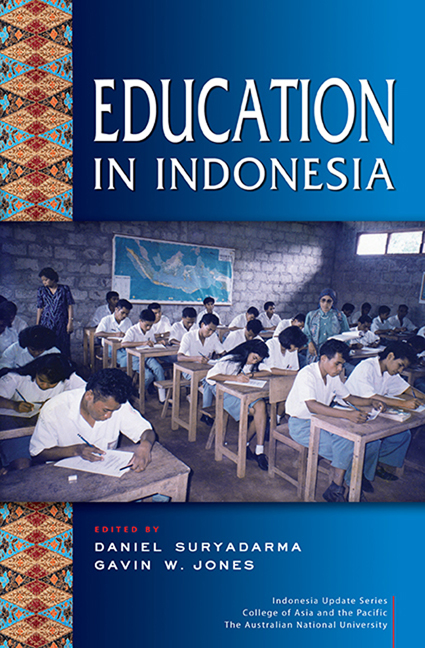Book contents
- Frontmatter
- Contents
- Tables
- Figures
- Contributors
- Acknowledgments
- Glossary
- 1 Meeting the Education Challenge
- 2 Trends in Education in Indonesia
- 3 Teacher Training, School Norms and Teacher Effectiveness in Indonesia
- 4 Integrating Islamic Schools into the Indonesian National Education System: A Case of Architecture over Implementation?
- 5 Early Childhood Education and Development Services in Indonesia
- 6 Where Did All the Money Go? Financing Basic Education in Indonesia
- 7 An Assessment of Policies to Improve Teacher Quality and Reduce Teacher Absenteeism
- 8 Indonesian Universities: Rapid Growth, Major Challenges
- 9 Beating the Odds: Locally Relevant Alternatives to World-class Universities
- 10 Financing Higher Education: The Viability of a Commercial Student Loan Scheme in Indonesia
- 11 The Transformation and Internationalization of Higher Education: The Malaysian Experience
- 12 Role of the Education and Training Sector in Addressing Skill Mismatch in Indonesia
- Index
- Indonesia Update Series
6 - Where Did All the Money Go? Financing Basic Education in Indonesia
Published online by Cambridge University Press: 21 October 2015
- Frontmatter
- Contents
- Tables
- Figures
- Contributors
- Acknowledgments
- Glossary
- 1 Meeting the Education Challenge
- 2 Trends in Education in Indonesia
- 3 Teacher Training, School Norms and Teacher Effectiveness in Indonesia
- 4 Integrating Islamic Schools into the Indonesian National Education System: A Case of Architecture over Implementation?
- 5 Early Childhood Education and Development Services in Indonesia
- 6 Where Did All the Money Go? Financing Basic Education in Indonesia
- 7 An Assessment of Policies to Improve Teacher Quality and Reduce Teacher Absenteeism
- 8 Indonesian Universities: Rapid Growth, Major Challenges
- 9 Beating the Odds: Locally Relevant Alternatives to World-class Universities
- 10 Financing Higher Education: The Viability of a Commercial Student Loan Scheme in Indonesia
- 11 The Transformation and Internationalization of Higher Education: The Malaysian Experience
- 12 Role of the Education and Training Sector in Addressing Skill Mismatch in Indonesia
- Index
- Indonesia Update Series
Summary
INTRODUCTION
Since emerging from the Asian financial crisis of 1997–98, Indonesia has embarked on a period of steady economic expansion and growing prosperity. Even by East Asian standards its post-crisis growth has been rapid, and Indonesia joined the ranks of middle-income countries in 2011. The benefits of growth have been shared widely across the population and poverty has declined significantly.
Economic growth coupled with prudent macroeconomic management has resulted in increasing revenues for the government, giving it the opportunity to invest more heavily in sectors vital to future development. Democratic decentralization began in parallel to multi-party elections at the national level in 1999. This has made locally elected governments responsible for providing basic public services to their electorates and shortened the lines of accountability between district populations and those responsible for local development.
These trends have had far-reaching consequences for the education sector. Education has been a key beneficiary of increased government spending. In 2009, a constitutional obligation for government to commit a fifth of the total budget to education was first achieved, releasing an avalanche of new funding. Since 2001, decentralization of the education system has meant that local governments have played a more direct role in setting sectoral priorities and in managing and financing their education systems.
The purpose of this chapter is to assess the impact that these changes, mainly the increased investment in education and the decentralization of management, have had on education sector performance. We will show that the recent increases in education spending by government and households alike have been associated with significant improvements in access to education, particularly among the poorest and most disadvantaged. Advancements in the quality of education, however, have been far harder to achieve. We argue that this disappointing result has been driven partly by unsuccessful but expensive policies aimed at improving teacher quality, but also by significant public spending inefficiencies at the district level associated with shortcomings in intergovernmental transfer mechanisms and weaknesses in local governance. Maintaining the impressive advances in the education sector will require improvements in the quality of spending. Improving governance of the education system will be crucial to these efforts.
- Type
- Chapter
- Information
- Education in Indonesia , pp. 109 - 138Publisher: ISEAS–Yusof Ishak InstitutePrint publication year: 2013

